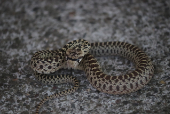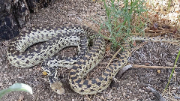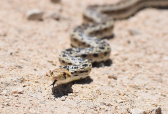|
Gopher Snake (Pituophis catenifer)
Description: Adults are 36 to 84 inches in length. Dorsally, they are yellowish or pale brown, with a series of large, dark brown or black blotches, and smaller, dark spots on the sides. Ventrally, they are yellowish, either uniform or with brown markings. They also come in several morphs depending on the subspecies.
Habitat: This species occurs in a wide range of habitats, extending from lowlands to mountains: desert, prairie, shrubland, woodland, open coniferous forest, farmland, and marshes. Midwestern populations inhabit prairies; western and Mexican populations range from coastal grasslands and forests through deserts into montane forests. This snake is terrestrial, fossorial, and arboreal. It remains underground in cold weather and during the hot midday period in summer; it may occupy mammal burrows or dig its own burrow, aided by the pointed snout and enlarged rostral scale.
Range: The species' range extends from southern British Columbia to Indiana, and south through all of western North America to northern Baja California , Sonora, Sinaloa and Zacatecas in Mexico.
Diet: Gopher snakes use constriction to capture and kill their prey. Typical prey include small mammals, birds, lizards, smaller snakes, insects, and eggs. Prey varies regionally but the primary prey in all areas are rodents and other small mammals. In some areas they prey mainly on gophers (Geomyidae), which is why they are called "gopher snakes." Gopher snakes actively search for prey in their burrows and hiding places. They often follow small mammal runways, and are quite successful in capturing voles (Microtus), western harvest mice (Reithrodontomys megalotis), Peromyscus species, kangaroo rats (Dipodomys), ground squirrels (Spermophilus), and young rabbits (Sylvilagus). They have also been known to eat bats in roosts. Lizards and snakes taken include side-blotched lizards (Uta) and rattlesnakes (Crotalus). They take birds, eggs, and insects occasionally as well.
Reproduction: Males compete for access to reproductively receptive females. Receptive females emit skin secretions that males detect through chemosensation and stimulates mating behaviors. Males will attempt to mate with as many receptive females as they can find. Males and females don't generally associate before or after mating. Gopher snakes breed once yearly, usually in June to August. Some females lay two clutches each year. They are oviparous and have an incubation period of 65 to 75 days. Once the 2 to 24 young hatch from the eggs, they are left to fend for themselves. It takes about 4 years for females to reach sexual maturity, but only 1.5 years for males. Eggs are deposited in burrows excavated by the female in loose soil, in spaces beneath large rocks or logs, or possibly in small mammal burrows.
Status: Listed as Least Concern in view of the large and relatively stable extent of occurrence, area of occupancy, number of subpopulations, and population size. No major threats exist.
»» Kingdom: Animalia - Animals
»» Phylum: Chordata - Chordates
»» Subphylum: Vertebrata - Vertebrates
»» Class: Reptilia - Reptiles
»» Order: Squamata - Scaled Reptiles
»» Suborder: Serpentes
»» Superfamily: Colubroidea
»» Family: Colubridae - Colubrids
»» Genus: Pituophis
»» Species: Pituophis catenifer - Gopher Snake
This article uses material from the Wikipedia article "Pituophis catenifer", which is released under the Creative Commons Attribution-Share-Alike License 3.0. Content may have been omitted from the original, but no content has been changed or extended.
|
|













